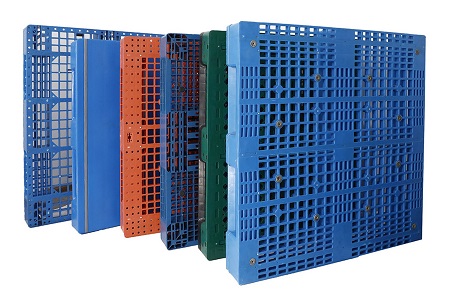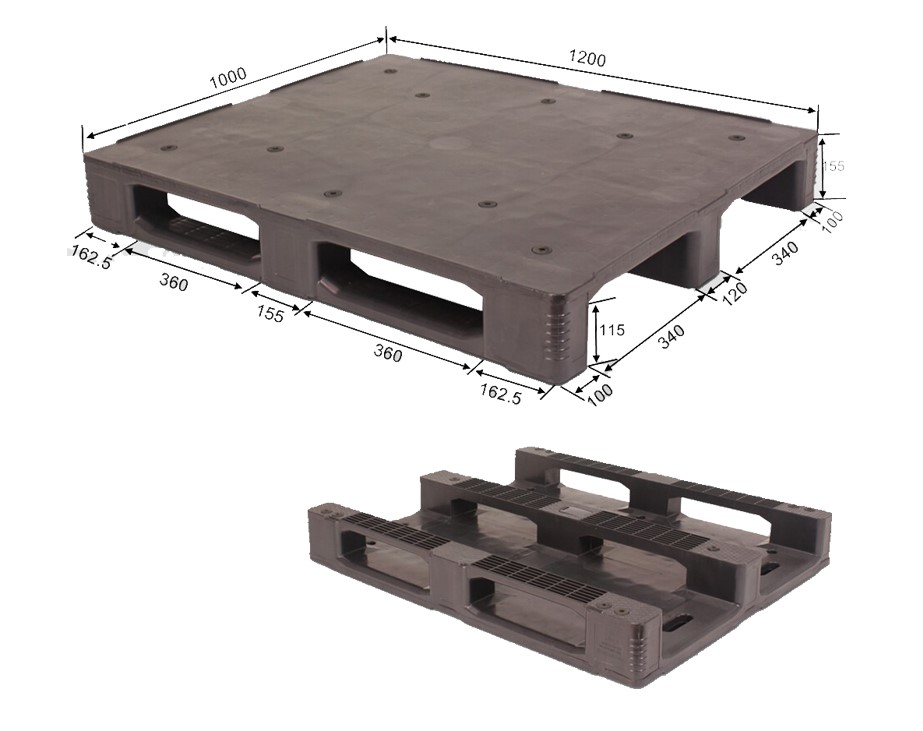
I. Introduction
A. Definition of Plastic Pallets
Plastic pallets are integral components in the realm of material handling, serving as robust platforms designed for the transportation and storage of goods. Unlike their traditional wooden counterparts, plastic pallets are crafted from durable polymers, providing a versatile solution to the evolving needs of various industries.
B. Significance in Material Handling
The significance of plastic pallets in material handling cannot be overstated. Their design ensures efficient handling, offering a balance between strength and weight. These pallets contribute to streamlined logistics, enhancing supply chain operations and warehouse management.
II. Material Composition and Manufacturing Process
A. High-Density Polyethylene (HDPE) vs. Polypropylene (PP)
The choice between HDPE and PP as primary materials for plastic pallets involves a careful consideration of factors such as strength, chemical resistance, and cost. HDPE excels in durability and impact resistance, making it suitable for heavy-duty applications. On the other hand, PP boasts superior chemical resistance, making it ideal for industries with stringent hygiene standards.
B. Injection Molding
Injection molding is a prevalent manufacturing process for plastic pallets. It involves melting polymer pellets and injecting the molten material into a mold, creating a precise and consistent product. This method ensures high production efficiency and allows for intricate design features.
C. Thermoforming
Thermoforming is a cost-effective alternative to injection molding. In this process, plastic sheets are heated and formed into the desired shape using a mold. While it may not match the precision of injection molding, thermoforming offers economic advantages, especially for standardized pallet designs.
D. Blow Molding
Blow molding is another technique employed in plastic pallet manufacturing. It involves inflating a hollow plastic preform inside a mold to achieve the final shape. This process is suitable for producing lightweight yet durable pallets, particularly for heavy-duty applications.

III. Advantages of Plastic Pallets
A. Durability and Longevity
One of the primary advantages of plastic pallets lies in their durability and longevity. Resistant to wear, weather, and various chemicals, plastic pallets outperform their wooden counterparts, ensuring a prolonged lifecycle.
B. Hygienic Properties
Plastic pallets offer superior hygienic properties, making them ideal for industries such as food and pharmaceuticals. Their non-porous surface resists moisture absorption and prevents the growth of bacteria, enhancing product safety.
C. Environmental Sustainability
Contrary to common misconceptions, plastic pallets can contribute to environmental sustainability. Many manufacturers use recycled materials in their production, and plastic pallets are fully recyclable. Additionally, their longer lifespan and reusability reduce the overall environmental impact.
D. Weight and Size Variability
Plastic pallets provide versatility in terms of weight capacity and size. They can be tailored to meet specific load-bearing requirements, ensuring efficient and secure transport of goods.
E. Compliance with Regulations and Standards
Plastic pallets comply with international regulations and standards, ensuring their suitability for various industries. They meet hygiene, safety, and quality standards, providing a reliable solution for businesses across the globe.
IV. Applications in Various Industries
A. Retail and Supply Chain
Plastic pallets play a crucial role in the retail and supply chain sectors, facilitating the seamless movement of products from manufacturers to distributors and retailers. Their durability and standardized sizing contribute to efficient warehouse management and transportation.
B. Food and Beverage
In the food and beverage industry, where hygiene is paramount, plastic pallets shine. Their resistance to moisture, chemicals, and bacteria makes them an ideal choice for transporting and storing food products safely.
C. Pharmaceutical and Healthcare
The pharmaceutical and healthcare industries demand stringent adherence to hygiene and safety standards. Plastic pallets, with their non-porous surfaces and resistance to contamination, ensure the integrity of pharmaceutical products during transportation and storage.
D. Automotive and Manufacturing
Plastic pallets find extensive use in the automotive and manufacturing sectors, where heavy loads and robust materials are essential. Their ability to withstand the rigors of industrial environments makes them a preferred choice for handling materials and products in these industries.
E. Export and International Shipping
For companies engaged in export and international shipping, plastic pallets offer a lightweight yet durable solution. Their compliance with international standards and resistance to
weather conditions make them ideal for global logistics.
V. Technological Innovations
A. RFID Integration for Tracking
Technological advancements, such as RFID integration, have enhanced the traceability of plastic pallets. RFID tags enable real-time tracking, providing valuable insights into the movement of goods within the supply chain.
B. Anti-Slip and Safety Features
Incorporating anti-slip and safety features into plastic pallet design has become a priority. These features enhance stability during handling and transportation, reducing the risk of accidents and product damage.
C. Automation Compatibility
With the increasing adoption of automation in warehouses, plastic pallets are designed to be compatible with automated handling systems. This ensures seamless integration with conveyor belts, robotic arms, and other automated technologies, further improving operational efficiency.
D. Smart Pallets and IoT Integration
The concept of smart pallets, incorporating Internet of Things (IoT) technology, is gaining traction. These pallets can provide real-time data on factors like temperature, humidity, and shock, ensuring the integrity of sensitive goods throughout the supply chain.

VI. Challenges and Solutions
A. Recycling and Environmental Concerns
1. Current Challenges
Despite the recyclability of plastic pallets, challenges exist in the recycling process, including the separation of different polymer types and contamination issues.
2. Emerging Solutions
Innovations in recycling technologies and increased awareness about sustainable practices are driving the development of solutions to address these challenges. Manufacturers are exploring ways to improve the recyclability of plastic pallets and reduce the environmental impact.
B. Cost Considerations
1. Initial Investment vs. Long-term Benefits
While the initial investment in plastic pallets may be higher than that of wooden pallets, the long-term benefits, including durability, reduced maintenance costs, and improved operational efficiency, often outweigh the initial expense.
2. Cost-Effective Alternatives
Manufacturers are exploring cost-effective alternatives without compromising quality. This includes optimizing production processes, sourcing recycled materials, and exploring innovative manufacturing techniques to offer competitive pricing.
VII. Future Trends and Industry Outlook
A. Adoption of Sustainable Materials
The plastic pallet industry is witnessing a shift towards the adoption of sustainable materials, such as bioplastics and recycled polymers. This trend aligns with the global focus on environmental conservation and circular economy principles.
B. Integration of Advanced Technologies
The integration of advanced technologies, such as artificial intelligence and machine learning, is expected to further optimize supply chain processes. Intelligent pallets capable of autonomous decision-making and self-monitoring could become commonplace.
C. Customization and Personalization
As industries evolve, the demand for customized and personalized plastic pallet solutions is expected to rise. Manufacturers will likely invest in flexible production processes to meet the unique requirements of different businesses.
D. Global Market Trends and Forecast
The global market for plastic pallets is projected to witness steady growth, driven by the increasing adoption of these pallets in emerging economies, technological advancements, and a growing emphasis on sustainable practices in supply chain management.
VIII. Conclusion
A. Recap of Key Points
Plastic pallets, with their durability, hygiene, and adaptability, have become indispensable in modern material handling. The choice between HDPE and PP, coupled with innovative manufacturing processes, contributes to their versatility and application across diverse industries.
B. Future Prospects for Plastic Pallets
The future prospects for plastic pallets appear promising, marked by a continual evolution to meet the changing demands of industries worldwide. As sustainable practices take center stage, the plastic pallet industry is expected to lead the way in adopting eco-friendly materials and processes.
C. Closing Remarks on the Industry's Evolution
The evolution of the plastic pallet industry reflects a dynamic response to the challenges and opportunities presented by the modern business landscape. From addressing environmental concerns to integrating cutting-edge technologies, the industry has showcased resilience and adaptability.
In conclusion, the adoption of plastic pallets has reshaped material handling practices across various sectors. Their durability, hygienic properties, and adaptability to technological advancements position them as a cornerstone in the optimization of supply chain operations. As the industry continues to navigate challenges and embrace innovations, plastic pallets are poised to play a pivotal role in the future of efficient and sustainable material handling. Businesses that strategically leverage these advancements will undoubtedly reap the long-term benefits of enhanced productivity, cost-effectiveness, and environmental responsibility.

 English
English




